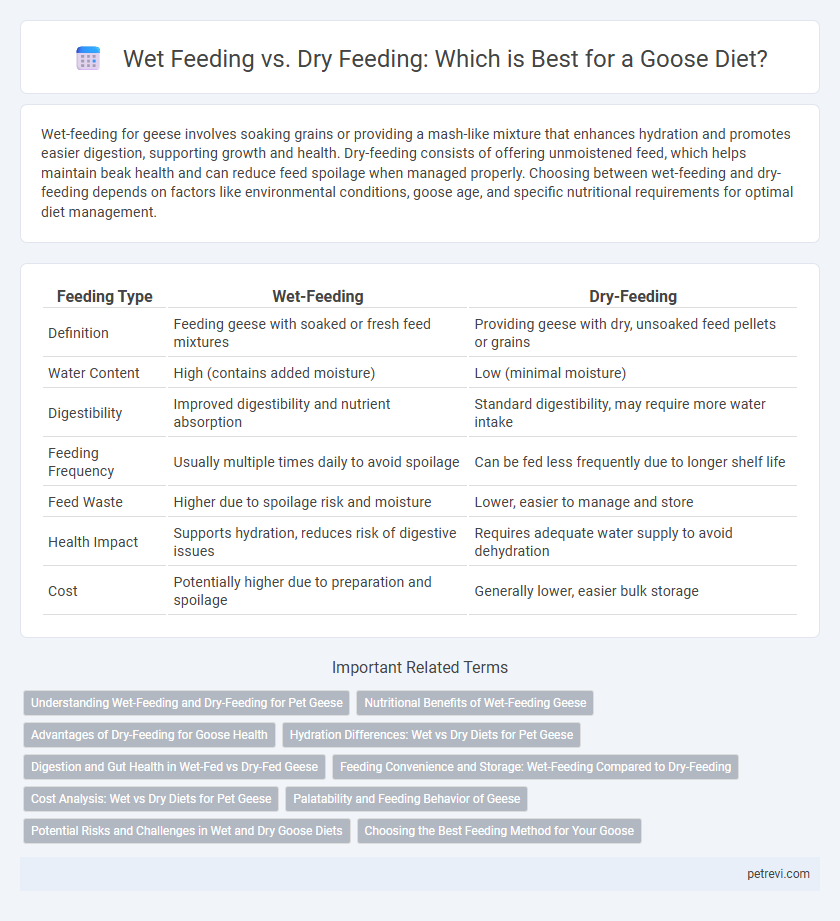Wet-feeding for geese involves soaking grains or providing a mash-like mixture that enhances hydration and promotes easier digestion, supporting growth and health. Dry-feeding consists of offering unmoistened feed, which helps maintain beak health and can reduce feed spoilage when managed properly. Choosing between wet-feeding and dry-feeding depends on factors like environmental conditions, goose age, and specific nutritional requirements for optimal diet management.
Table of Comparison
| Feeding Type | Wet-Feeding | Dry-Feeding |
|---|---|---|
| Definition | Feeding geese with soaked or fresh feed mixtures | Providing geese with dry, unsoaked feed pellets or grains |
| Water Content | High (contains added moisture) | Low (minimal moisture) |
| Digestibility | Improved digestibility and nutrient absorption | Standard digestibility, may require more water intake |
| Feeding Frequency | Usually multiple times daily to avoid spoilage | Can be fed less frequently due to longer shelf life |
| Feed Waste | Higher due to spoilage risk and moisture | Lower, easier to manage and store |
| Health Impact | Supports hydration, reduces risk of digestive issues | Requires adequate water supply to avoid dehydration |
| Cost | Potentially higher due to preparation and spoilage | Generally lower, easier bulk storage |
Understanding Wet-Feeding and Dry-Feeding for Pet Geese
Wet-feeding for pet geese involves mixing grains with water or other liquids to create a mash that aids digestion and increases water intake, enhancing nutrient absorption. Dry-feeding consists of offering dry grains or pellets, which encourages natural foraging behavior and dental health by promoting chewing. Balancing wet-feeding and dry-feeding can optimize nutrition, hydration, and overall health in pet geese.
Nutritional Benefits of Wet-Feeding Geese
Wet-feeding geese enhances nutrient absorption due to increased hydration and improved digestibility of feed components, leading to better growth performance and higher egg production. The moisture content in wet feed aids in the efficient breakdown of fibrous materials, optimizing energy utilization and promoting gut health. Studies indicate that wet-feeding diets result in elevated protein and mineral uptake, supporting overall metabolic functions and immune system strength in geese.
Advantages of Dry-Feeding for Goose Health
Dry-feeding in goose diets enhances nutrient absorption by providing consistent feed quality and reducing contamination risks associated with moisture. It supports better gastrointestinal health by minimizing the growth of harmful bacteria and fungi common in wet feeds. Moreover, dry-feeding improves feed efficiency and reduces waste, promoting optimal growth and overall health in geese.
Hydration Differences: Wet vs Dry Diets for Pet Geese
Wet-feeding for pet geese provides higher hydration levels, supporting optimal kidney function and overall health by ensuring consistent water intake through their diet. In contrast, dry-feeding requires geese to consume more drinking water to maintain hydration, which can lead to variable water consumption and inefficient nutrient absorption. Balancing moisture content in feed is crucial to prevent dehydration and promote digestive health in captive geese.
Digestion and Gut Health in Wet-Fed vs Dry-Fed Geese
Wet-feeding geese enhances digestion by increasing water intake, which softens feed and promotes efficient nutrient absorption, supporting optimal gut health. Dry-feeding, while convenient, may lead to slower digestion and a higher risk of gastrointestinal issues due to reduced moisture content in the diet. Maintaining a balanced feeding approach with adequate hydration is crucial for sustaining a healthy gut microbiota and preventing digestive disorders in geese.
Feeding Convenience and Storage: Wet-Feeding Compared to Dry-Feeding
Wet-feeding offers easier immediate consumption for geese as it involves moist, palatable feed that encourages intake, reducing feed waste compared to dry-feeding. Storage of wet-feed requires refrigerated or sealed containers to prevent spoilage and microbial growth, increasing logistical efforts compared to dry-feed, which is more stable and easier to store long-term in dry, cool environments. Feeding convenience favors wet-feed during active growth phases or cold climates, while dry-feed ensures longer shelf life and simpler bulk storage for extended feeding plans.
Cost Analysis: Wet vs Dry Diets for Pet Geese
Wet-feeding in geese involves providing soaked grains or mixed feed, which can enhance nutrient absorption but often leads to higher feed wastage and increased labor costs. Dry-feeding is more cost-effective due to reduced spoilage and easier storage, resulting in lower overall expenses for pet geese keepers. Analyzing long-term costs, dry diets typically offer improved feed efficiency and savings, making them preferable for budget-conscious goose owners.
Palatability and Feeding Behavior of Geese
Wet-feeding enhances palatability for geese by softening feed particles, encouraging natural foraging and increasing intake rates compared to dry-feeding. Geese exhibit more active feeding behavior with wet feed, as moisture stimulates their sensory receptors and mimics the texture of aquatic vegetation. Dry-feeding may limit feed consumption due to reduced palatability and less engagement in natural feeding patterns intrinsic to geese.
Potential Risks and Challenges in Wet and Dry Goose Diets
Wet-feeding in goose diets poses risks such as increased microbial contamination and feed spoilage, leading to potential digestive disorders and reduced nutrient absorption. Dry-feeding challenges include lower palatability and potential selective feeding, which may result in nutrient imbalances and slower growth rates. Both feeding methods require careful management to minimize health risks and optimize nutrient intake for optimal goose performance.
Choosing the Best Feeding Method for Your Goose
Wet-feeding for geese involves mixing feed with water or other liquids, enhancing nutrient absorption and hydration, while dry-feeding offers convenience and reduces spoilage risks. Choosing the best method depends on factors like flock size, climate, and the goose's health requirements, as wet-feeding supports digestion and growth, whereas dry-feeding suits maintenance and ease of management. Optimal goose nutrition balances feed type, ensuring adequate protein, fiber, and vitamins to promote robust development and overall well-being.
Wet-feeding vs Dry-feeding for Goose Diet Infographic

 petrevi.com
petrevi.com